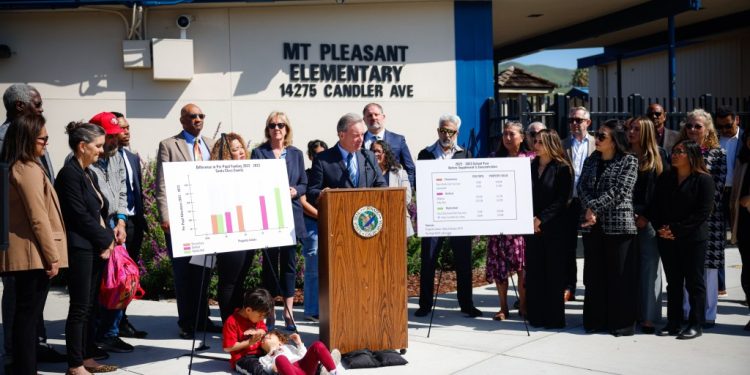While schools in the Bay region are faced with budgetary deficits of several million dollars and the Trump administration has threatened to retain dollars in federal education, a new bill of a South Bay democrat aims to level out the rules of the game and stabilize school funding in California.
Presented by Senator Dave Cortese, which represents Silicon Valley, the Senate bill 743 would establish an educational endowment using money from the general state fund to fill the shortcomings of the financing of school districts. The endowment would only be funded in the years when there is a budgetary surplus and it is not yet clear how much money would enter it.
“It is a bill that will correct long -standing inequalities in California public schools,” said Cortese on Friday. “For too long, where a child lives determined the funding of the school.”
Palo Alto Unified, for example, received around $ 22,500 per student during the 2022-23 school year, compared to Milpitas Unified, which obtained about $ 10,500.
The proposed bill arrives at a pivotal moment in education in California. The districts of the Bay region face budgetary deficits ranging from $ 20 million to $ 113 million and turned to closings and school layoffs to connect the holes.
Franklin-McKinley’s San Jose’s school district recently became the last to announce closings and school layoffs when the school board voted to close three schools in order to repair a budget deficit of $ 22.9 million earlier this year.
Others, such as Oakland Unified, Hayward Unified, Fremont Unified, Dublin Unified and West Costa Unified are considering layoffs or job discounts to combat budgetary deficits and are preparing to decrease federal funding.
President Donald Trump also called for the dismantling of the American education department, which provides around $ 8 billion in funding for schools in California K-12. The Trump administration threatened Thursday to retain the federal funds of public schools from kindergarten to 12th year, unless the leaders in state education confirm the elimination of diversity, equity and inclusion programs.
The Cortese bill would strengthen school districts, which are mainly relying on public funds and would generally receive less overall funding than districts of areas supported by higher property taxes.
In school districts like Palo Alto Unified and Santa Clara Unified, property tax revenues are relatively high, so these school districts receive a minimum of public funds and obtain pocket of land tax revenue. Districts can use these funds to pay music, art and other programs that certain nearby districts cannot afford. But in less rich districts, property tax revenue is relatively low, therefore state financing represents a larger part of the district budget.
Although all California schools receive financing for local land taxes, the introduction of proposal 13 has changed the way schools count on them, explained Ken Kapphahn from the legislative analyst’s office – a non -partisan tax and political agency which advises the California legislature. Before the promulgation of Prop 13 in 1978, each local school district set its own land tax rates, which meant that schools were massively based on local property tax revenues. But Prop 13 capped property taxes, limiting the funds that schools receive.
The result? The total amount that each district receives by student can vary considerably.
Cortese has declared that divergence creates inequalities among school districts and exacerbates the existing disadvantages that students in the lower economic areas are confronted.
Glenn Vander Zee, the Superintendent of the East Side Union High School District in San Jose, said that under the current financing formula, his district receives much less funding by student than the districts just 20 minutes by car.
“Although our students are invited to learn the same state standards, to use the same approved textbooks and meet the same entry requirements for all students in the University of California system, they are not currently supported,” said Vander ZEE on Thursday.
SB 743 would aim to fill this gap. It would put a voting measure before voters seek a constitutional amendment protecting an educational endowment as well as certain details on how money would be distributed.
The signing of the bill could be a difficult battle, however.
“My feeling is that, given the many requests in the state budget this year, this bill is an attempt to establish a principle that could be prosecuted in the future, but it is unlikely that it will adopt this year,” Thad Kouser, professor of political science at UC San Diego, told.
Although the Howard Jarvis Taxpayers Association has not yet taken a position on the bill, the anti-fiscal organization has been expressed in the concern of any impact on potential taxpayers, an increase in education funding could have.
“Education expenses are at record levels if we understand it,” said Susan Shelley, vice-president of the organization’s communications. “California is in the event of a budgetary emergency … and this puts pressure on the state to potentially examine the tax increases, which the inhabitants of California cannot afford. Affairs is an enormous problem in this state, so everything that leans in the sense of larger requirements for taxpayers will be a problem. ”
The California Teachers Association also said that it had not yet taken a position on the bill.
The Cortese bill should go to the Senate Education Committee on Wednesday.
Cortese has recognized that any bill with a “credits label” will probably face obstacles to the state’s legislature. But he said that more funds for school districts will only help students by providing additional resources to schools to increase test results, provide a more rigorous study program and improve diploma rates.
“This bill concerns equity (and) the opportunity. Giving each student that the resources he needs to succeed is expected for a long time,” said Cortese. “No child should simply be disadvantaged because of the place where their parents have chosen to live.”
California Daily Newspapers


